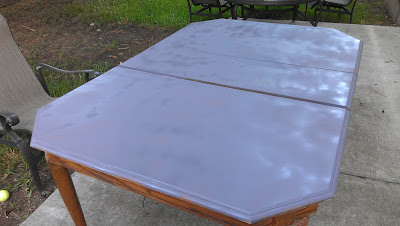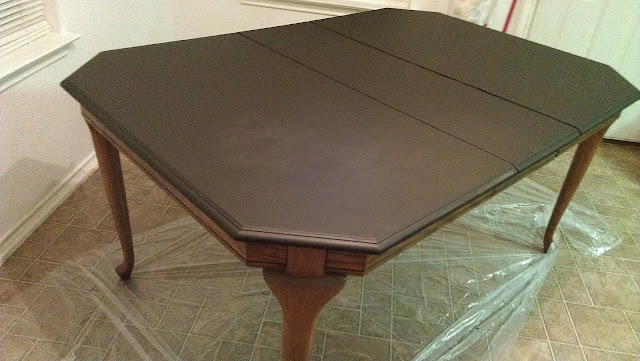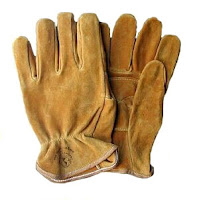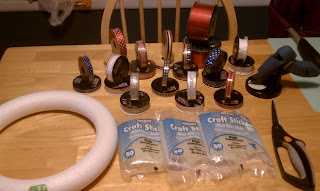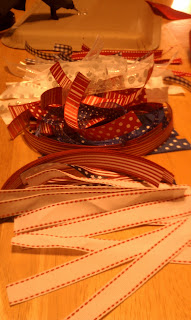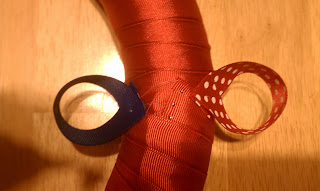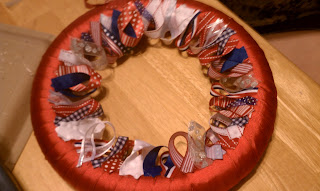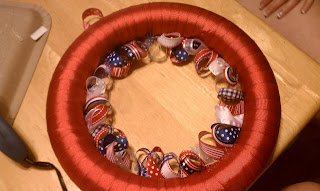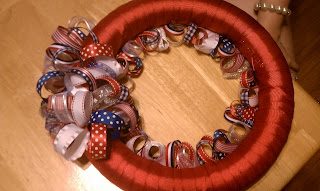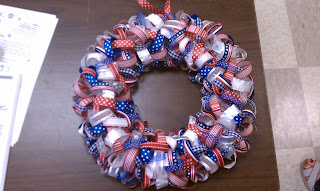If there's one thing that having a dad in the medical field has taught me, it's that safety is the
most important thing. Bike helmets, volleyball knee pads, soccer shin guards and rollerblading wrist braces were all standard in my house growing up. Mom and Dad didn't care how stupid you looked, as long as you were safe.
It is something that has really stuck with me as I've grown up, and even in my teens I always wore a seat belt, looked both ways before crossing the street and pointed my scissors towards the floor when I carried them. To this day, I tuck my fingers in when I'm using a knife, light the grill with the lid up and wear gloves when I'm using household cleaners. I just figure 'better safe than sorry and sitting in the ER waiting room.'
So here are a few of my crafting and DIY safety tips. Please, always use your common sense and if you're not sure, ask someone who knows or for heaven's sake, just Google it.
When sanding, always wear a mask. Especially if you're sanding something with paint on it, and ESPECIALLY if the paint job is older than a few years. You don't want to inhale lead dust, I promise. Masks are also a good idea when you're using power tools on MDF and particle board, cutting or breaking glass, painting, staining, applying poly acrylic or urethane, and using solvents. I keep a stash in my tool bucket, and they are pretty much infinitely reusable, at least until they fall apart or get so clogged that you can no longer breathe.
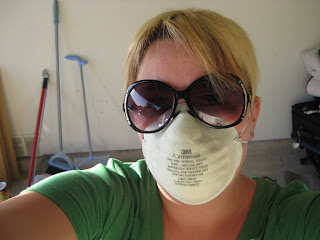
Eye protection comes in all shapes and sizes, and you need it any time you use a power tool, from sanders to saws to drills to paint sprayers. It only takes one speck in your eye to cause a serious problem. I usually work in my garage with the door up and the Texas sun shining in, so I often use a big pair of sunglasses, but I also have a pair of clear safety glasses for cloudy days or indoor work. Make sure they completely cover your eyes, and it's best if they wrap around the sides, too. You can pick up a pair for as little as $1, or you can invest up to $50 on a good pair. Pro tip: buy like, five pairs of the $1 ones and stash them around your work area. They scratch, break and get lost like crazy, and I absolutely hate making last minute trips to the hardware store for something as small as a pair of safety glasses, but I won't work without them.
 |
| This is how I usually look in my garage. Scary, right? |
Hearing protection is often overlooked, but VERY important. It's easy to underestimate the damage a loud, droning noise can do to your ears, especially when you're using power tools and you keep turning them on and off for short periods. Hearing pro should be used with saws, sanders, nail guns and other intense noise-making tools. Even if you're only using it for a minute. I use a pair of noise blockers worn by flight line workers. In fact, that's where I got these - I used to work on the flight line back in England, and they issued me my very own pair.
You don't have to learn about weapons guidance systems, work on plane engines or join the BASH team (seriously, I did that - look it up, it's hilarious) to get good hearing pro - you can buy it from the Blue store for a couple bucks. But the airplane stuff is way cooler, I'm not going to lie.

You know what people never use, but should? Gloves. You need two kinds, at least: latex or nitrile or vinyl gloves for painting, staining and stripping, and heavy duty canvas or leather gloves for gripping and handling sharp or rough things. You could also get a nice pair of heavy duty rubber gloves for using solvents or acids. That would really round out your glove collection. Nobody ever owns a good pair of gloves and I don't know why. They're cheap reusable and infinitely useful. Get some.

Let's talk about glue guns. Even if you are using a low-temperature craft glue gun, that thing had to get hot enough to melt a solid stick of glue. And not just melt it, liquify it enough that it can be extruded through a small metal hole. So that sucker is
hot. Your glue gun, in my opinion, should always have two things: a stand and an 'off' switch. I know it's a pain to unplug the gun every time you aren't going to use it for more than three minutes. That's how crafting works. So a gun with an 'on' and 'off' switch is priceless. And I know they exist, I've seen them. Look, there's even a picture of the exact one I bought the other day. As far as stands go, it's going to do a few things for you. It's going to keep your gun from leaking glue onto itself (they all do it if you lay them sideways) and it's going to keep that hot metal nozzle from touching and burning anything else, like say, its own cord. See how that wouldn't be good? Also, it goes without saying, but please do not operate a hot glue gun while your children are around. Yes, 2nd degree burns heal, but do you really want that to happen in the first place? Just save it for nap or bed time, like my friend Kathryn does.
Craft knives, X-Acto knives, box cutters and blades of all kinds: keep them out of reach of your children and any slow-witted, clumsy people who may hang around your house. I've seen people get stitches from a craft knife - they are wicked sharp. I mean, they have to be. And in the garage, I keep a box cutter in my pocket for opening things, scoring wood, chipping paint, prying the catches open on my sander, you name it. They're dead useful. But I'm telling you, even a clean cut with a sharp blade will bleed
forever and possibly need stitches. And it will cut through you like butter, my friend. Tasty, tasty butter. It's one of the many perks of having friends and family in the medical field, but I have a few rolls of butterfly tape around here somewhere for just such occasions. And a craft knife can inflict a puncture wound that will require not only stitches but a tetanus shot. Do you really want that? No? Then always treat your sharps with respect. Use canvas or leather gloves when you change the blades on your knives, and if you use a breakaway blade on your box cutter, you need eye pro
and gloves
and no one else around when you break to the next blade. Remember to keep a cap on all of your knives or retract the blades when they're not in use, and keep them put away out of reach of children.
Here's the thing about scissors. If you're a crafter, you know that you can't use paper scissors to cut fabric and you can't use fabric scissors to cut paper and you can't use either to cut crafty materials like foils, pipe cleaners or glue sticks. So chances are, you own at least three pairs of good, sharp scissors. I myself own about half a dozen, all earmarked for specific craftiness. Plus a pair of pinking shears. SO I'm assuming you know Scissor Safety, since we all learned it in Kindergarten. But then, you know what they say about assuming - something about a donkey - so I'm going to conduct a little review. Walk, never run. When carrying your scissors, hold them closed and keep the pointy end pointed at the ground. When you pass the scissors, always hold them by the (closed) blades and pass the handles to the other person. Keep your scissors sharp - dull scissors, like dull cooking knives, are more dangerous than super sharp ones. If you are buying scissors that cost less than about $25
per pair, don't bother having them sharpened, just buy a new pair. Seriously. Sharpen your stainless steel, heavy duty sewing scissors. Sharpen your Ginghers. But just replace your Fiskars.
Sewing machines require a lot more safety checks than you'd think to keep them operating without coming alive and killing you a la the AC unit in Brave Little Toaster. You need to oil it, clean it out with Q-tips (especially where your bobbin sits and the part where your needle goes up) and check the cords regularly for fray. In fact, just suck it up and have that thing serviced every few miles of stitches. It's cheap and saves you a lot of heartache later when you're halfway through quilting a blanket that you have to give as a gift tomorrow and your machine craps out on you. Been there, hand-quilted that. Also, and this is a touchy subject, so don't eat me if you disagree, but I have to tell you not to sew over your pins. Don't. I do, but this is definitely a case of 'do as I say, not as I do,' especially if you are a new sewer. It's just dangerous, and it's a gamble every time you sew over a pin - will my needle hit it this time? Will it break? Will the broken needle come flying at my face? Just don't. And if you're me, feel free to have a backup machine (or five) chillin' in your house. Not only do I have a backup machine that is identical to my primary, I have a vintage backup electric for when I'm feeling nostalgic, an electric from WWII that would probably electrocute me if I tried to plug it in and two manual machines; one that has a hand crank on the side and one that operates by foot treadle. And they're all in perfect working condition, except the WWII one. I hate hand sewing
that much.

Power Tools: discuss. I'll go first. Have some respect for your power tools, okay? We've all heard the stories, we've all had the shop teacher who was missing some appendages. Remember to lock your cords like the picture to the right to keep them from coming undone in the middle of a project. Always use an extension cord that is both rated for the tool you're using and no longer than you need. To this end, I'm installing a surge protecting power strip to the back of my workbench to eliminate the need for extension cords on any but the biggest projects. Never put your hands near a blade, running or not, and never
ever change or adjust any part of your tool while it is plugged in. Yeah, that's right, I unplug my sander to change the paper because turning it off isn't good enough for me. That's just how I roll. Please never use power tools alone - you need someone nearby who knows what you're up to. That way, if you're bleeding out on the garage floor, your person might notice that either A) you're screaming or B) the power tools have stopped and come check on you. Saved your life! In all seriousness, if you're not comfortable with a tool, you don't need to be using it by yourself. I'm not going to tell you that these tools are hard to use, but they do require some strength and at least the experience of practicing on a 2x4 before you begin a project. If you're using a public workshop, just ask the supervisor guy for help - that's what he's there for. If you're doing it by yourself, ask me and if I don't know, I'll call my dad or Mr. Neil.
For the love of God, tie back your hair and wear old clothes. That's not blasphemy, I'm really exhorting Him to convince you of this. I know, Martha Stewart does it in a dicky and a cashmere sweater, but
you're not Martha.
No one is watching you or paying you to look pretty while you craft. (And if they are and you're reading this blog anyway, I need a sponsor, let's talk.) We
all harbor these grand images of creating beautiful pieces of art while
dressed in our favorite Pinterest outfit, sitting at a craft table in a
pristine, tastefully decorated room. But I craft at my kitchen table,
among cereal bowls and spoons, or in my sawdust-filled garage where I have to sweep away roly poly bugs before I get started. And I
think I make some pretty nice crap. Plus, you'll be sad once you ruin
that nice shirt with oil from your sewing machine, or cut it on accident
when you drop your blade, or somehow manage to fling paint at yourself. Your work clothes should consist of a short-sleeved shirt (if it's cold and you need sleeves, make sure they're tight and come down no further than your wrists), jeans or jean shorts that are not baggy and won't fall down, and close-toed shoes. Work boots would be awesome if you're going to be in a garage, but as long as they're closed, pretty much anything is good.
If you ever look at pictures of me when I'm working with tools, paint
or glue, you'll see that I wear the same green shirt and jeans. I
recently bought a pair of shorts so I don't die of heat exhaustion
in my garage, but still. Same clothes, every time. While we're on the subject of clothes, there's this: tie back your hair. I keep mine cut very short so this isn't an issue for me, but when I was younger my hair was so long that I could sit on it. Seriously, ask anyone I went to high school with. And when I worked with my dad, it had to be braided and wound up out of the way. The last thing you want is to get your hair caught in a power tool, dipped in paint (especially oil-based paint or shellac) or falling in your face while you negotiate a difficult seam on your sewing machine.
A few other tips from a crafter:
- Read your paint. Indoor, outdoor, latex, oil, nontoxic - these are all really important things to consider before you get started. But I'm going to do a whole post on paint, so I won't go into that right now.
- Keep your work area clean. Nothing is more frustrating than trying to craft in a messy space. Or more dangerous.
- Invest. Cheap tools beget cheap work. So you can't afford to have six different paper cutting blades like me. Pick the most useful, fine tip blade you see and buy the next-to-nicest version they have. I'll tell you a secret: I always start off with the basics when I'm learning a new craft and accumulate pieces over time. It took me years to get all of those blades, one at a time.
- Please don't use heirloom fabric, hardwood, oil based paint or handmade paper for your first project. I am so serious about this, it isn't even funny. It will not end well. For your first sewing project, use quilting fabric. For your first woodworking project, use pine or an old piece of furniture that you care absolutely nothing about. For your first paper cutting, use computer paper or scrapbook paper. Because your first project will absolutely, 100% guarantee NOT turn out the way you imagined. It just won't, because you don't know what you're doing, you're still learning. And I would hate to see you waste beautiful, expensive materials on something you're not going to be happy with. Save the good stuff for your third or fourth project, once you've had a chance to learn from that first experience and grow as a crafter.


